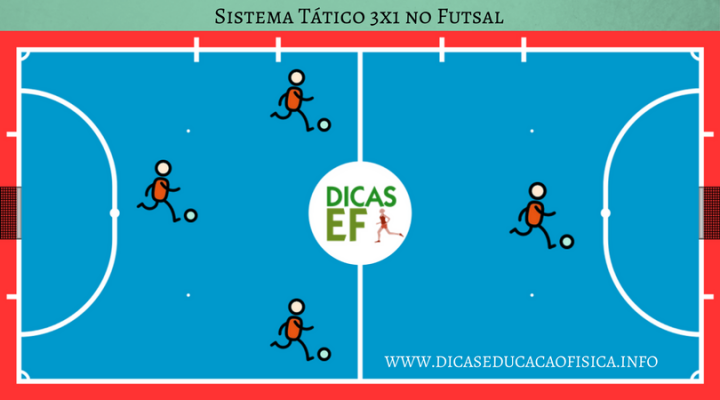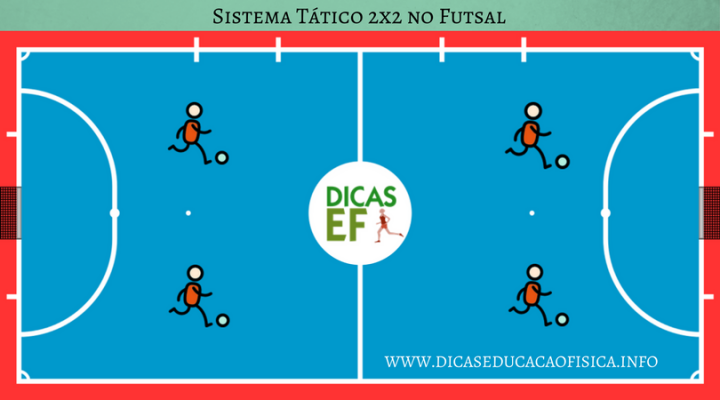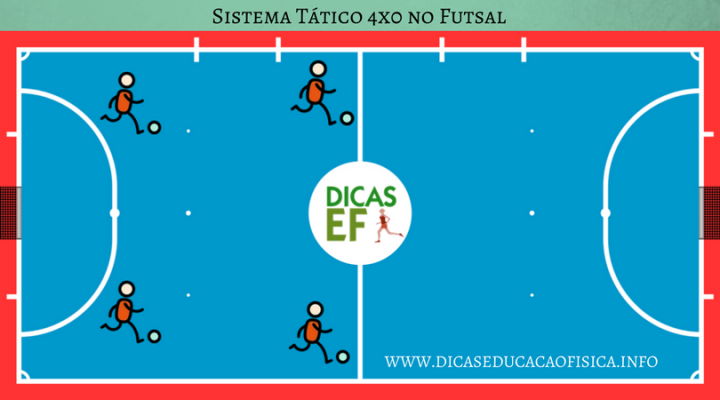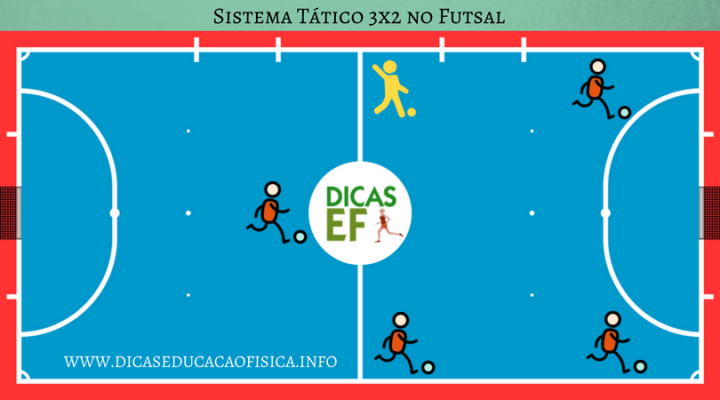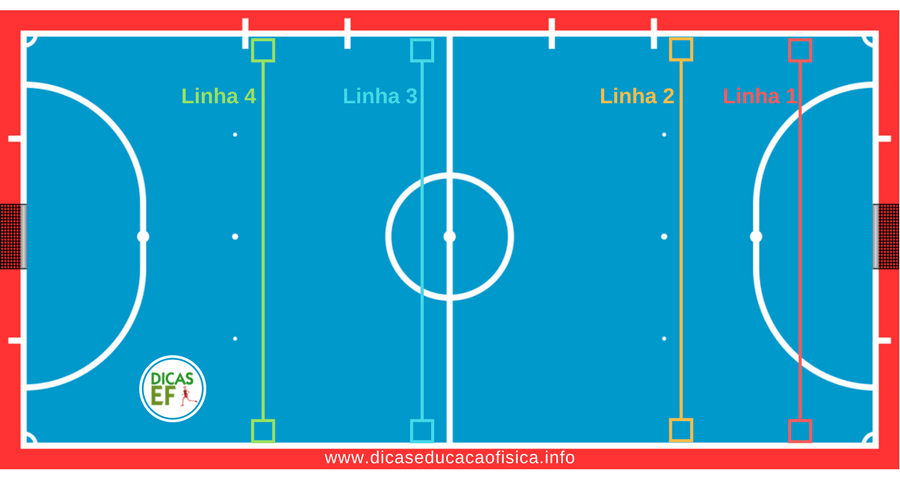Introduction: Futsal Tactical System
In Futsal Tactical System, The DEF presents the tactical systems and concepts of Futsal. We will talk about futsal offensive systems, futsal defensive systems, types of marking in Futsal and futsal defensive lines.
What is a Futsal tactical system?
A tactical system or tactical scheme is the way a Futsal team positions itself on the court, to attack or to defend.
How to choose a tactical system?
The choice of the game system for a Futsal team must occur from the characteristics of the players who make up the team. If you are a Futsal coach, don’t try to impose your team a tactical scheme without taking into account the characteristics of your players.
The best tactical training depends on a few factors:
- against whom are you playing against?
- What are the characteristics of your team’s players?
- What is the fitness level of your team’s players?
“Thebest way to apply any tactical system is to keep in mind how your basic defense formation,that is, when your team runs out of possession of the ball, it’s this standard of organization that players should follow on the court.”
Get it! When the team is attacking Futsal’s tactics are also important, however, due to the great movement by the occupation of space, there should not be a rigidity in the positioning of players in attack.
See also – The History of Futsal in the World
Below we will analyze with the advantages and disadvantages of the main tactical systems of Futsal.
Futsal 3×1 tactical system or Diamond
This is one of the most common formations in Futsal,it provides balance between defense and attack. It has a player dedicated to attack (the Pivot), while there is also a player dedicated to the defense (the Fixed). There are also two Wards, the Right Wing and the Left Wing who must support both the defense and the attack.
Advantages of the 3×1 System:
- There is clearly a player with the leading defense specialist and an attacking specialist player
- The team gets more compact both to defend and to attack
Disadvantages of the 3×1 System
- If both wards focus too much on the attack it will leave the defense too exposed and Fixed overloaded
- You can also overload the Pivot if the Wards have offensive difficulties
2×2 or Square Futsal Tactical System
The 2×2 Futsal Tactical System, also known as “Square,” basically divides the four line players of a team into the two main areas of responsibility: defense and attack. It is a simple system that can help develop good pairs of defenders and attackers.
Although two players are told to become more advanced (in attack) and two to get more indented (in defence), these roles will need to be quite flexible, as the attackers will need to help the defense and vice versa. In addition most teams attack and defend with at least three players.
Advantages of the 2×2 System in Futsal
- Great system for beginners
- It strikes balance between attack and defense.
- It ensures that the defense and attack have at least one player at all times in the game.
Disadvantages of the 2×2 System in Futsal
- Restricts player movement
- It can be defensively weak if defenders join the attack and the attackers are unwilling to perform defensive duties
- Whether the team is untrained or not communicating well on the court there may be confusion between which of the attackers should support the defense and between which defender should support the attack.
Futsal Tactical System 4×0 system
Futsal 4×0 tactical system is used by high-level teams such as professional teams. The idea is to have all 4 players moving at once, promoting a move that allows many table options, space occupancy and attack opportunities.
Advantages of the 4×0 System in Futsal
- Promotes more dynamic team drive
- Always allows table options
- Makes it difficult to defend the opposing team due to great movement
- Physically can wear the defending team
- The ball moves extremely fast
- Great option to maintain possession of the ball
- Facilitates space occupancy
- Best way out of pressure marking
- Makes it difficult to cover the opposing team
Disadvantages of the 4×0 System
- Everyone on the court MUST understand the system otherwise it will not work!
- Players must be extremely well conditioned physically
- If players focus too much on moving the team gets predictable and unoffensive
- Players MUST be technically good
- Players MUST be agile
- Generates a lot of physical wear
Futsal 3×2 tactical system
The 3×2 Futsal Tactical System happens when the goalkeeper (Goalkeeper Line) leaves his area to participate in his team’s attacking moves. Usually the goalkeeper is replaced by a line player, to make this system more offensively efficient. With this training players do not change positions often. They try to tire the defenders by passing the ball quickly in every corner of the court.
DETAIL: In the image above the Goalkeeper (yellow) is positioned on the attacking court, this happens because the Futsal rule restricts the goalkeeper’s possession of the ball on the defense court, he cannot receive the ball more than once and cannot stay with it for more than 4 seconds (being on the defense court).
“In this formation it is important that the players have enough accuracy in the passes and expect a very clear opportunity to kick the goal, because a hasty kick or a wrong pass can be fatal, since the goalkeeper will be out of his goal.”
Advantages of the 3×2 System
- You create a numerical advantage when attacking
- Enables the creation of clear opportunities for submissions
Disadvantages of the 3×2 System
- There is a great risk of suffering a counterattack goal, as the goalkeeper is out of the goal in this system
- The team can play with a goalkeeper not expert in defending
FUTSAL TACTICAL SYSTEMS VIDEO
Watch the Channel Video Physical Education Tips on Futsal Offensive Tactical Systems.
Futsal Defensive System
What is the purpose of futsal’s defensive system?
A good defensive system of Futsal is the one that makes a good mark of the opposing team. The goal of the scoring in Futsal is to prevent the opponent from making successful offensive plays, however, without making too many fouls. Futsal rules punish excess fouls with direct free kicks, so scoring should be efficient without being overly aggressive.
Futsal Fouls and Defensive System
Having a good defensive system is the best way to avoid too many fouls in a Futsal game. If athletes know their roles and defensive positions well, marking will be much more of a tactical issue than aggressiveness, and this will avoid an excessive number of fouls.
Physical Preparation and Futsal Defensive System
With the development of physical preparation, the marking in Futsal has also evolved a lot, because currently futsal athletes can occupy the spaces more efficiently, in addition they are more resistant and can better monitor the offensive movement of the Opponents.
Elements of the Futsal Defensive System
Futsal’s defensive system consists of the types of marking (as it is marked), and defensive lines or defensive variations (where it is marked). A Futsal team can score individually, by zone or in a mixed way.
Individual Marking in Futsal
The individual marking in Futsal is the popular “each, score one”, that is, each player will be responsible for scoring a specific opponent player of the opposing team, anywhere on the court where he moves.
The positive points of individual marking are:
-
makes it difficult to kick long distance;
-
decreases the pass option;
-
forces the adversary error;
-
greater physical wear and tear of opponents due to the need for greater movement to get out of the marking;
-
decreases the opponent’s ball possession time;
-
Decreases the reaction time of the opponent to think about what move to perform.
Negative points of individual marking:
-
promotes great physical wear of defenders to keep up with the movement of attackers;
-
leaves the middle of the court open facilitating throws, infiltrations and “balls on the back”;
-
the opposing team can take a numerical advantage when they achieve a dribble, making it difficult to recover and cover.
Zone Marking in Futsal
In the futsal zone marking each defender is responsible for marking in a sector of the court, the opposing player who occupies that sector is the one who will be marked. In the marking by zone the defender should not follow the opponent throughout the court, only follow the opponents who enter their marking zone. It is a marking used when the opposing team has a good movement with exchange of passes or when the team is ahead on the scoreboard. A lot of training is required to make a good marking by zone.
Positive points of zone marking:
-
facilitates coverage and recovery in the case of dribbling;
-
less physical wear and tear of defenders;
-
provides good possibilities for counterattacks;
-
makes it difficult to “ball in the back” and closes well the middle of the court.
Negative points of the marking by zone:
- allows long-range kick;
- increases the ball possession time of the opposing team;
- can partially cover up the goalkeeper’s vision.
Mixed Marking in Futsal
Mixed marking is one that uses zone marking combined with individual marking, basically it comes down to marking an opponent individually, while other players are scored by zone.
3×1 Defensive System or Diamond
The 3×1 defensive system or diamond is a tacticalfutsal isthes used against teams using the 3×1 or 3×2 tactical system. s The wingers must make the “swing” or the “back and forth” as the sides of the field football, the pivot must close the middle preventing the ball from being thrown to the opposing pivot. If this happens he should re-sandwich the opponent, doubling the mark along with the fixed of his team. The fixed, besides being concerned about the opposing pivot, needs to be attentive to the coverage of other players, because he is the last man of defense (SAAD, 2005).
2×2 or Square Defensive System
The 2×2 or Square defensive system is a tacticalfutsal isthes used against teams playing in the 2×2 or 4×0 tactical system. s Two players are positioned further ahead and hold their positions, only touching the opponents who “enter” their zone. The two most retreated players will make the marking of the two most advanced players of the opposing team.
Defensive Lines and Futsal Defensive System
Futsal’s defensive lines are associated with the idea of space, the more advanced the defensive line, the less space is left for opposing team to play.
First Defensive Line
The first defensive line or line 1, is the one made in the defense court of the opponent, close to the opposing goal, the so-called marking under pressure, aiming to suffocate the ball output of the opposing team. Thus, the marking on the first defensive line is a type of marking that leaves little room for the opponent to leave playing.
Second Defensive Line
The second defensive line of futsal or line 2 is the half pressuremarking. In this defensive positioning the goalkeeper has a little more space for the exit of the ball, however, as soon as the ball is dominated by an opposing player, the team advances to the first line of defense,increasing the pressure on the marking.
Third Defensive Line
The third defensive line of Futsal or line 3 is the marking half court,because in this defensive positioning the team is positioned from the middle of the court, leaving opponents unmarked on their defensive court, but when the opponents enter the attack court, suffer strong marking. The goal of this defensive positioning is to avoid infiltration, “ball in the back”, close the middle of the court and play on counterattacks.
Fourth Defensive Line
The fourth defensive line of Futsal or line 4 is a type of defensive positioning quite indented, made near the line of 10 meters in the defense court. In this system the opposing team will have enough space to keep the ball, however, they will not have spaces for infiltrations or tables. The goal of this defensive positioning is also the game of counterattacks.
VIDEO TYPES OF MARKING IN FUTSAL
Watch the Video Types of Tagging in Futsal Channel Tips Physical Education.
